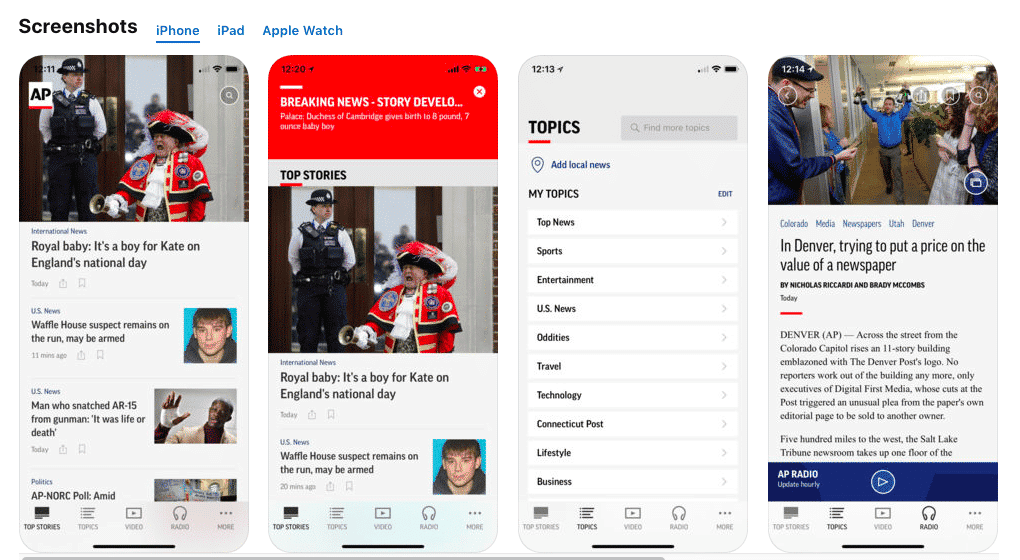Article
When Mobile is the New Newsstand: Q&A with The AP’s Sean McCorkle
June 14, 2018

It’s no secret that many legacy publishers struggle with digital transformation. And few publishers are as “legacy” as the Associated Press, which dates back to 1846 when five New York City newspapers funded a pony express route through Alabama to deliver news of the Mexican War. Still, the AP has always been future-focused and navigated successfully through many technological disruptions. In fact, the AP launched the App Store’s first news app in 2008 and hasn’t slowed down since, thanks in part to Sean McCorkle.
A 20+ year veteran of the mobile space, Sean is the AP’s Director of Product Development and Growth for Digital Services. That means he oversees development of all of the AP’s many direct-to-consumer and B2B2C digital products.
We caught up with him to talk about how AP’s platform and the publishing industry have, and will continue to evolve, over the years. We also spoke about personalization in publishing and why mobile is the new newsstand.
What have been some of the most exciting and challenging aspects of The AP becoming a digital-first media brand?
Sean McCorkle: Like everyone else, we are trying to understand both the changing behaviors of news consumers and also the evolving needs of our journalists to tell stories in the social and mobile world. This is an exciting place to be, but it’s not without its challenges.
When I started about seven years ago, we were still fairly new to the mobile space. And while we were the first news app in the iOS App Store, we’ve been constantly working to improve our products and work closely with internal stakeholders to provide more useful and meaningful experiences for users.
AP Mobile, which was the predecessor of AP News, was one of the first platforms where our journalists could see their work, untouched in a live environment. This really opened some eyes and helped us rethink about how content should be produced. Editorial now has a mobile-first mindset when producing stories and uses the AP News platform as a sandbox to come up with new storytelling ideas. It’s been very exciting to see that shift toward mobile, which has helped us stay relevant in the digital-first world.

How do you think mobile, web, and apps are changing the way publishing businesses operate?
Sean McCorkle: Digital platforms have really changed the way publishers connect with people and tell stories. You have to appeal to people quickly, on a more personalized level and in different ways, depending on where they are and how distracted they are.
Publishers now have to think about creating content in multiple formats. Story layouts also have to work on multiple screen sizes. This is a challenge when you are producing a very high volume of content. That’s all very different from what we have traditionally done throughout our history.
As a publisher, what artificial intelligence/machine learning use cases excite you the most and why?
Sean McCorkle: I think that machine learning is going to have a massive impact on how we are able to personalize experiences for our readers. The AP produces a high volume of content every day so one of the biggest challenges is finding ways to facilitate discovery. This requires content to be tagged relevantly so that it can be delivered or searched for effectively.
On an enterprise level, automation of resource-intensive, structured tasks saves time and resources. We have already seen this work on financial reports. We also potentially see AI and machine learning playing a part in analyzing visual content so that it can be tagged and organized in more useful, meaningful ways. This ultimately will provide better user experiences.
What advice would you give to other publishers taking their first step into focusing on mobile apps as a new marketing channel?
Sean McCorkle: At this point, every new project should be taking a mobile-first approach. More than 75% of our traffic comes from mobile devices and I am sure others see similar levels. It’s critical that publishers listen to their users and data. Creating a mobile app is a first step. But it requires constant attention, adjustments, tweaks and improvements to keep the business growing. It is not a set-and-forget type of platform. So make sure that you provide a place for feedback and listen to it.
But my best advice would be to respect your users. Be sensitive to the advertising experiences, which can quickly cost you users. Keep the experiences simple, clean, fast and lite so that users want to come back.
In what ways do you see today’s media and publishing industry evolving in the next few years?
Sean McCorkle: I think we’re going to see a lot more use of machine learning to personalize experiences for individual users. I also think we will see a shift in monetization strategies. Advertising may evolve, but I think that more publishers will be using blended monetization strategies in the future as more payment mechanisms become available.
I’m curious to see where augmented reality takes us. That’s an area I think is going to have a big impact on the news industry. I can’t wait to see how that evolves.
The State of Brand Loyalty in the U.S. in 2023
Related



